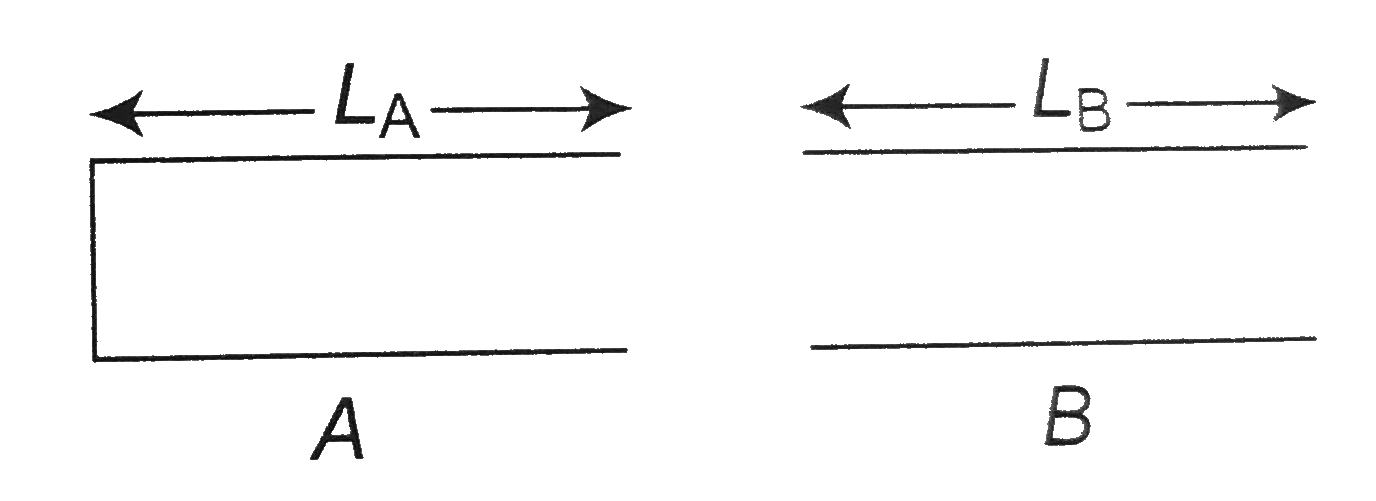
The two pipes are submerged in sea water, arranged as shown in figure. Pipe A with length LA=1.5m and one open end, contains a small sound source that sets up the standing wave with the second lowest resonant frequency of that pipe. Sound from pipe A sets up resonance in pipe B, which has both ends open. The resonance is at the second lowest resonant frequency of pipe B. The length of the pipe B is
(a) Only odd harmonics can exist in a pipe with one open end. The resonant frequencies are given by f = nv/4L for harmonic numbers n = 1,3,5,....
Because resonant frequency increases with increasing n, the second lowest resonant frequency corresponds to n = 3, the second lowest choice of n.
(b) Any harmonic can exist in a pipe with two open ends. The resonant frequencies are given by f = n/2L for harmonic numbers n = 1,2,3,...
Because resonant frequency increases with increasing n, the second lowest resonant frequency corresponds to n = 2, the second lowest choice of n. Therefore, we can write
f=2v2LB
Solving for LB and substituting known data yield
LB=vf=1522m/s761Hz=2.00m
Topper's Solved these Questions
- WAVE - IIBOOK - RESNICK AND HALLIDAYCHAPTER - WAVE - IIEXERCISE - CHECKPOINTS
4 Videos
- WAVE - IIBOOK - RESNICK AND HALLIDAYCHAPTER - WAVE - IIEXERCISE - PROBLEMS
59 Videos
- VECTORS BOOK - RESNICK AND HALLIDAYCHAPTER - VECTORS EXERCISE - PRACTICE QUESTIONS
39 Videos
- WAVES-IBOOK - RESNICK AND HALLIDAYCHAPTER - WAVES-IEXERCISE - Practice Questions (Integer Type)
4 Videos
Similar Questions
The two pipes are submerged in sea water, arranged as shown in figure. Pipe A with length LA=1.5m and one open end, contains a small sound source that sets up the standing wave with the second towards resonant freiquency of that pipe. Sound from pipe A set up resonance in pipe B, which has both ends open. The resonance is at the second lowest resonant frequency of pipe B. The length of the pipe B in meter is :

View Solution
The two pipes are submerged in sea water, arranged as shown in figure. Pipe A with length LA=1.5m and one open end, contains a small sound source that sets up the standing wave with the second lowest resonant frequency of that pipe. Sound from pipe A sets up resonance in pipe B, which has both ends open. The resonance is at the second lowest resonant frequency of pipe B. The length of the pipe B is
View Solution
Knowledge Check
Two pipes are submerged in sea water , arranged as shown in figure . Pipe (A) with length LA=1.5m and one open end , contains a small source that sets up the standing wave with the second lowest resonant frequency of that pipe . Sound from pipe A sets up resonance in pipe B , which has both ends open . The resonance is at the second lowest resonant frequency of pipe B. The length of the pipe B is :
 A1mB1.5mC2mD3m
A1mB1.5mC2mD3mA closed pipe of length 10 cm has its fundamental frequency half that of the second overtone of an open pipe . The length of the open pipe .
A10 cmB20 cmC30 cmD40 cmWhen the open organ pipe resonates in its fundamental mode then at the centre of the pipe
Athe gas molecules undergo vibrations of maximum amplitudeBthe gas molecules are at restCthe pressure of the gas is constantDthe pressure of the gas undergoes maximum variation
Pipe A has length twice the pipe B. Pipe A has both ends open and pipe B has one end open. Which harmonics of pipe A have a frequency that matches a resonance frequency of pipe B.
View SolutionOrgan pipe A, with both ends open, has a fundamental frequency of 425 Hz. The fifth harmonic of organ pipe B, with one end open, has the same frequency as the second harmonic of pipe A. How long are (a) pipe A and (b) pipe B?
View SolutionThe second overtone of an open pipe has the same frequency as the first overtone of a closed pipe 2 m long. The length of the open pipe is
View SolutionAn organ pipe of length L is open at one end and closed at other end. The wavelengths of the three lowest resonating frequencies that can be produced by this pipe are
View SolutionThe waves set up in pipes open at both the ends are
View Solution